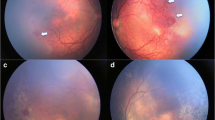Abstract
MA is a 9-month-old Mongolian girl was born prematurely with 1.7-kg birth weight. She received supplemental oxygen for an extended period of time. Her mother stated that her daughter would not look at her face and that her eyes “wandered back and forth.” She had been told at the government hospital that cataract surgery could be attempted but “there might be some complications,” so she sought another opinion when she heard that some Japanese eye doctors were visiting a local clinic.
You have full access to this open access chapter, Download chapter PDF
Similar content being viewed by others
Keywords
These keywords were added by machine and not by the authors. This process is experimental and the keywords may be updated as the learning algorithm improves.
MA is a 9-month-old Mongolian girl was born prematurely with 1.7-kg birth weight. She received supplemental oxygen for an extended period of time. Her mother stated that her daughter would not look at her face and that her eyes “wandered back and forth.” She had been told at the government hospital that cataract surgery could be attempted but “there might be some complications,” so she sought another opinion when she heard that some Japanese eye doctors were visiting a local clinic.
Examination showed an absent red reflex bilaterally and a poor view of the fundi. Lens opacities were noted bilaterally. The child had a moderate searching pendular nystagmus and would not fixate to light with either eye.
B-scan revealed membranous loops in the right eye consistent with an anterior retinal detachment (Fig. 1). Echography of the left eye showed a high-reflective “funnel” inserting into the optic disc that was typical for a total retinal detachment (Fig. 2). The mother was told that the prognosis was poor for vision, but the doctors promised to discuss the child’s case with a vitreoretinal specialist when they returned to Japan.
Echography can help to identify those cases that may be benefited by the latest surgical instrumentation in expert hands. Patients can be advised to seek such care if available in their own country or to travel to other areas if they have the resources. A number of nongovernmental organizations (NGO), such as ORBIS, send teams of ophthalmic specialists to developing countries, and this can provide a resource to refer appropriate cases.
Author information
Authors and Affiliations
Rights and permissions
Copyright information
© 2014 Springer Science+Business Media New York
About this chapter
Cite this chapter
Harrie, R.P., Kendall, C.J. (2014). Case Study 185 Retinopathy of Prematurity and Retinal Detachment. In: Clinical Ophthalmic Echography. Springer, New York, NY. https://doi.org/10.1007/978-1-4614-7082-3_185
Download citation
DOI: https://doi.org/10.1007/978-1-4614-7082-3_185
Published:
Publisher Name: Springer, New York, NY
Print ISBN: 978-1-4614-7081-6
Online ISBN: 978-1-4614-7082-3
eBook Packages: MedicineMedicine (R0)






